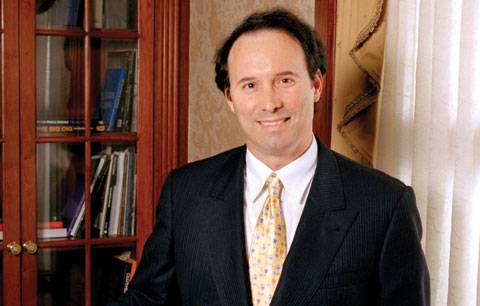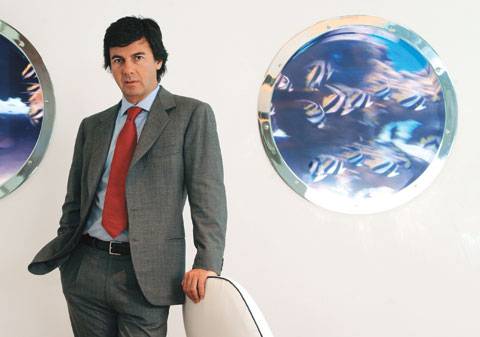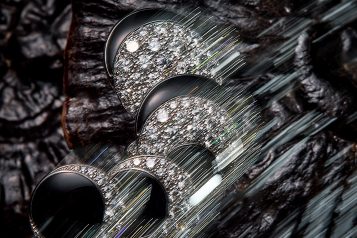After pioneering the concept of chic hotels, visionary Ian Schrager has moved onward and upward to create his first-ever residential properties, Gramercy park and 40 bond street. And those are just the beginning.
By Lois Weiss and Lauren Price
“The longer the hotel’s interiors remain a secret, the more people try to figure it all out.”
What Vera Wang is to bridal fashions, Ian Schrager is to hotels and residential condominiums. So if you think that Studio 54 put the style-savvy Schrager on the map, think again. More likely it was the opening of Morgans on Madison Avenue in 1984, an impossibly hip hotel that, seemingly overnight, became an industry standard for boutique hotels everywhere. Founded with his longtime friend and partner, the late Steve Rubell, the Morgans Hotel Group went on from there to open the Royalton, the first-ever hotel project for the over-the-top designer Philippe Starck, who has continued to work with Schrager in the years since.
So successful for its unique mix of glamour and seductive cool, Morgans’ current portfolio now includes hotels New York, Miami, Los Angeles, San Francisco and London.
Last year, Schrager cashed out from his investment banker partners. “One of the reasons I left the company was that I wasn’t enjoying myself,” he explains. “And I had all the administrative responsibilities and obligations that come with running a big company.” He adds, “Thing is, when I go through a construction site I get sort of energized – I just love that. I can’t stand being in an office all day.”
So, while he remains a well-paid consultant for the Morgans Hotel Group, Schrager recently created the Ian Schrager Company, and though hotels will indeed be part of that company’s portfolio, he has turned his attention to upscale residential developments as well.
Having purchased the historic Gramercy Park Hotel in the city’s oldest residential neighborhood, Schrager, in collaboration with longtime partners Michael Overington (he began as a busboy at Studio 54 three decades ago) and design architect Anda Andrei (she worked on the Royalton’s design with Schrager some 25 years ago) and artist cum writer cum film director Julian Schnabel is redesigning the landmark as a luxury hotel. Set to open this spring amid huge amounts of media buzz, the hotel portion is a total departure from Schrager’s usual model. “It’s special and quirky and original, and it’s unlike anything anybody has ever seen before,” he says of the soon-to-be-revealed hotel rooms.
Built on the site of Stanford White’s home, the hotel opened its doors in 1924. Over the years, it became famous for the fact that Humphrey Bogart married his first wife, stage actress Helen Menken, on the rooftop terrace in 1926. The Kennedy clan took up residence on the third floor for several months in 1927 (President Kennedy was 11 years old at the time), and Babe Ruth imbibed potent potables at its wildly popular bar. Other famous guests and residents included S. J. Perelman (he co-wrote Horse Feathers and Monkey Business for the Marx Brothers and won an Oscar for penning Around the World in Eighty Days) who actually died in room 1621 in 1979, and husband-and-wife authors Mary McCarthy and Edmund Wilson in the 1940s.
The neighborhood is also famous for Teddy Roosevelt (he was born 28 East 20th Street) and the National Arts Club, which happens to be inside the city’s largest Victorian mansion. But as the decades passed, the hotel became less famous and a bit seedier. “It was a dump, but it was unique, quite charming and very special,” Schrager says. “It had the right DNA, much like the Chelsea Hotel and the Plaza ,the kind of hotel that every New Yorker knows about.”
When we met up with Schrager in early April, he was still determined to keep the hotel rooms and lobby under wraps. Part of the secrecy of the $200 million project is to prevent copycats from stealing his concepts, designs and business models. “It’s a new kind of Ian Schrager,” he says. “The visuals, people will think are new and spectacular and original.”
More importantly, this long-time hotelier who’s got the art of hospitality down pat wants his new hotel to be known for its indulgent service, not just for its good looks. “It’s funny,” he muses. “The longer the hotel’s interiors remain a secret, the more people try to figure it all out.”
Asked how he came to choose Schnabel as his collaborator, Schrager reveals that it was after getting a look at some of the artist’s other projects (he wrote and directed Basquiat and Before Night Falls, and more recently painted, photographed and directed the Red Hot Chili Peppers’ album cover). “But when he did the film Before Night Falls and was able to switch to another medium, it made me realize how talented he was,” Schrager says. “He’s incredibly talented and visual.” As for the hotel’s overall theme, Schrager said, “It’s going to be impossible to categorize. It’s going to be somewhat bohemian, more eclectic.”
For the 24 park-facing apartments set inside the hotel’s annex, Schrager, in a partnership with Aby Rose of RFR Holdings, selected minimalist architect John Pawson (he of New York Calvin Klein’s New York flagship store fame). Nearly completed, it is Schrager’s first foray into residential development – and lucky buyers enjoy not just great views and the hotel as their “private clubhouse,” but also coveted access to the neighborhood’s famous gated park, which, by the way, received a $100,000 donation from Schrager back in 2004.
“For the apartments, the idea was to provide good bones and a clean envelope so people could go in and decorate them however they wanted,” said Schrager. “The hotel is more in my vision, but for the apartments, we wanted it to be a home where people could create their own vision. So that’s the difference.”
As much as Schrager is an arbiter of spot-on style, he also knows a good location when he sees it. Now a year into his new game, the 11-story, 28-unit 40 Bond is yet another brilliant addition to the Ian Schrager Company portfolio. Currently being developed from the ground up in yet another historic part of town, the favorably positioned building is located on Bond Street between Lafayette Street and the Bowery in SoHo.
With a nod to Manhattan’s largest collection of pre-Civil War cast-iron buildings, he’s putting a reinterpreted, modern twist on the landmark-designated loft buildings found along the Belgian-brick (not cobblestone) and bottle-green glass streets of SoHo, which also seems the neighborhood of choice for incognito celebrities seeking a New York address.
Teaming up again with developer Aby Rosen, who also owns both the Mies van der Rohe-designed Seagram Building and Gordon Bunshaft-designed Lever House on Park Avenue, the building’s glass façade, with its structural columns wrapped in hand-blown glass from Barcelona, will produce visually stunning streaks of light throughout the day. The show-stopping interiors come courtesy of Pritzker Prize architect laureates Jacques Herzog and Pierre de Meuron of Switzerland-based Herzog & Meuron. “Aby Rosen is my partner, but more importantly before that, my friend,” Schrager explains. “Aby has a love and appreciation for architecture and design as I do, so it’s great to share all this with him, because that has been the great joy of my life. It’s really what makes me get up in the morning.”
Boasting 19th-century cast-iron sensibilities, the multimillion-dollar, stylishly procured homes all feature no less than 11-foot-high ceilings, and wide-plank Austrian smoked oak wood floors and quite a few come with working fireplaces framed in cast-iron hearths and palatial outdoor terraces. Ranging from enormous one- to expansive four-bedroom lofts, master baths come with wet rooms (Schrager grabbed one of the terraced lofts for himself and his two daughters), there are five sprawling, honest-to-God triplex townhouses that happen to be the first townhouses to be built in the city in decades. Surrounded by 22-foot-high, cast-aluminum, graffiti-inspired gates designed by Herzog and dubbed Gaudíesque by Schrager (40 Bond’s lobby walls are imprinted with the same graffiti-ish patter, as are all the tubs and showers, embossed to prevent slips and falls), each sports private Bond Street entrances, back and front gardens (the rear yards are outfitted for outdoor kitchens). Providing all the benefits of living in a five-star hotel, standout amenities expected by discerning buyers include round-the-clock complimentary access to the services and privileges at the Gramercy Park Hotel.
On the building’s web site, Herzog says: “When we decided to do gates, it was essential that they integrate with the New York street. We wanted to create something solid, rough and chaotic…so we began to experiment with New York City street graffiti, which became the starting point of the design.” To Schrager, the graffiti gate is “a flamboyant gesture” and makes the project fit in with the neighborhood. Set to welcome residences next spring, this well-conceived project is also exclusively marketed and sold by the Corcoran Sunshine Group.
Schrager is not one to stop with a few good projects, so more are on the way. He is getting them done with the support of employees like Michael Overington, and design architect Anda Andrei. These new projects include the conversion of One Madison’s North Tower (a.k.a. Clocktower) that overlooks Madison Square Park near 24th Street into 100 top-tier condominiums. A joint venture with Aby Rosen, SL Green Realty Corp. and Credit Suisse, this landmark, 43-story skyscraper, modeled on the famous bell tower in St Mark’s Square (Campanile di San Marco) in Venice, was the world’s tallest building when it went up in 1909. A full-block property acquired by SL Green, the site includes a 14-story office building that SL Green is keeping.
“One Madison Avenue,” Marc Holliday, president and chief executive officer of SL Green, said in the March 16th announcement, “is indicative of the type of opportunity that can be uncovered today in classic New York City office buildings. As soon as we were aware of its availability, we saw an opportunity to offer a world-class address for both business and residential occupancy when we assumed ownership of the Clocktower as part of the acquisition. There is no one better than Ian Schrager at creating and defining cutting-edge lifestyle trends. He’s proven that over and over again.” No timetable has been announced for the conversion of the 43-story building to 100 luxury condominiums.
Schrager has recently purchased two hotels in Miami and Miami Beach. One will be designed as a “stylish monastery on the beach,” courtesy of John Pawson, who coincidentally just recently finished designing a new Bohemia Cistercian Trappist monk monastery in the Czech Republic. Believe it or not, that project came as a result of the abbot seeing a photo of Calvin Klein’s Madison Avenue store. “The rates will be maybe half of what is currently being offered by the competition,” Schrager says. “The idea is to give young people the same access to stylishness without paying the kinds of rates that they would pay at the other hotels I have done.”
As a consultant for the Morgans Hotel Group and their 50/50 joint venture with Nevada-based Boyd Gaming Corporation (they own and operate 19 gaming properties, including Atlantic City’s Borgata) in Las Vegas, Schrager will develop two of their signature hotel brands, a 1,000-room Mondrian and 600-room Delano (including bungalows) at Echelon Place as a world-class entertainment destination on the Stardust Hotel’s current 63-acre Las Vegas Strip set to open in 2010.
Believe it or not, Schrager has no “strategies” to grow his current company. “Because I respond in a visceral, emotional way, there is no logic to it,” he says. “I don’t do it just because it’s good for business, but because there has to be something special about it. Pretty much the same criteria that makes somebody buy a car or a house.”
With his passionate commitment to ahead-of-the-curve ventures, he absolutely does see future residential opportunities and shared with us his wish for actually building communities.





















